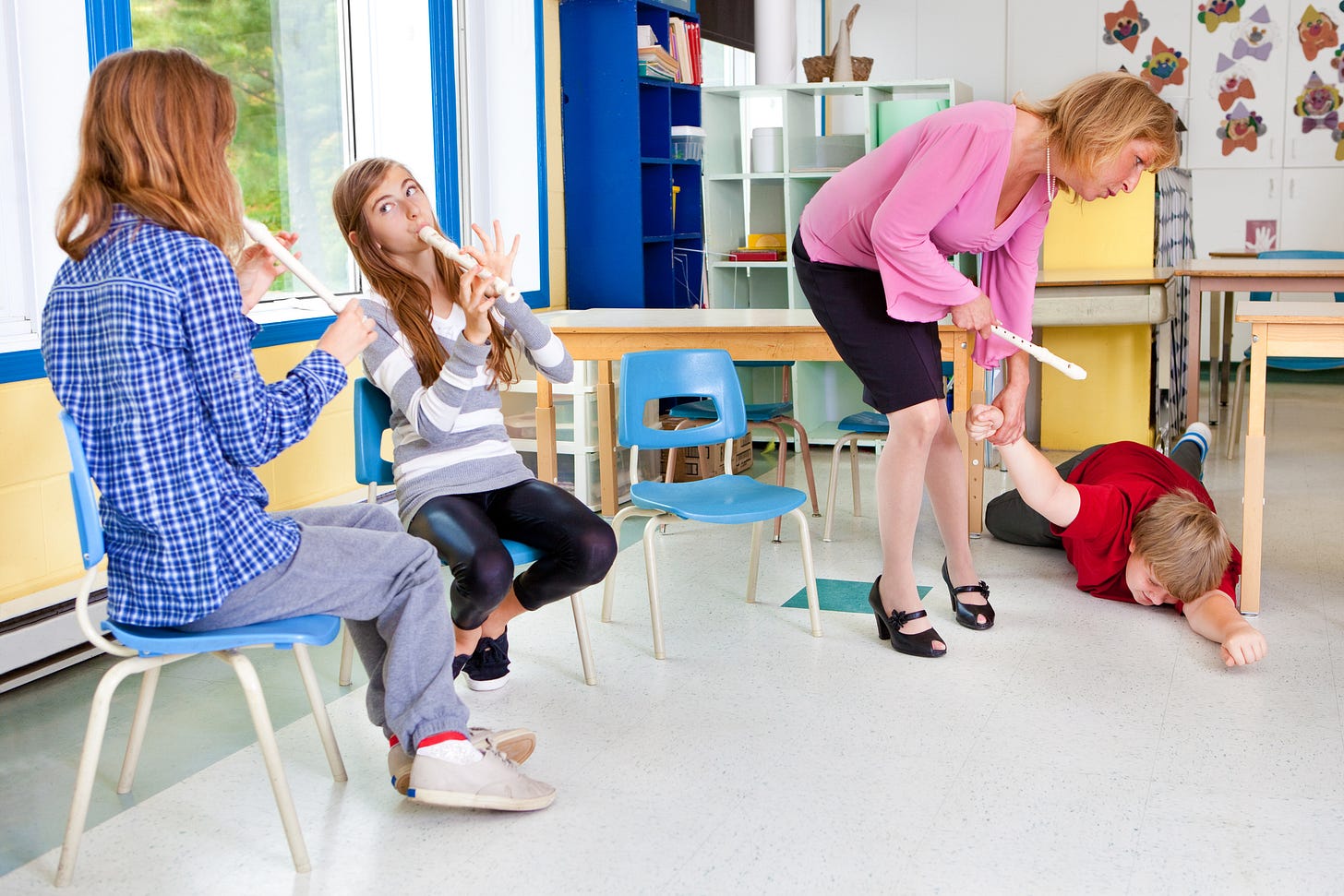[Redacted] and Loathing in Las Vegas
The CM Files. Part Four: "Avoid Fear-Based Teaching" [Edited and republished from 6/24/24]
I. YOU KEEP USING THAT WORD. I DO NOT THINK IT MEANS WHAT YOU THINK IT MEANS.
In this time of a growing backlash against screen-based learning in schools (citing the ledger of harms from such devices, combined with unfettered access to the internet for kids), let’s talk about an oft-repeated tack by Educators in favor of it. It goes like this: “We shouldn’t be teaching a fear-based curriculum.”
I hope we all can agree that Human Child Development (talking ages 0 through 25, when the frontal lobe is fully developed, here) is a big topic—worthy of robust debate. So, when we encounter a bumper-sticker level argument, perhaps our instinct should be one of skepticism.
As I say, taking place right now is a growing backlash against smartphones in schools—and by extension, the screen-based “1:1” “Ed Tech” movement in education (where, say, each child is assigned, as a matter of course, their own tablet with net access). And, while I would not sign on to an argument against Ed Tech or 1:1 in all circumstances for all age learners, I think the same is true for the opposite: The arguments FOR Ed Tech/1:1 for ALL KIDS in ALL CIRCUMSTANCES are equally inappropriate. But, of course, that does seem to be the point of it. Across Big Tech board rooms, everywhere, you can almost hear the call going forth: Get each of the$e kids a $creen…$tat!
Now, from how often and how reflexively it's used, I'm tempted to call the entire “fear-based” thing a meme. But, to be intellectually honest, I can't. This is because there is a well-established body of scientific research showing that fear-based teaching isn’t effective. However: Those research findings and what the Ed Tech proponents are using as talking points are two completely different definitions!
II. TRULY FEAR-BASED CURRICULUM
First off: To clear it up, when the research talks about fear-based education, they mean the educational environment.
For example, the stereotypical mean professor who threatens punishment for the slightest violation of the syllabus or class rules. Or, as I can attest, Law School: where they let you know during your orientation that you’re probably not going to graduate. This is one of their go-to talking points during your orientation. Reflecting the actual statistics, they say:
‘Look at the person to your left, now look at the person on your right—only one of you will become an attorney.’
Or they just play mind-games to try and get you to lose your cool (proper practice for dealing with some Judges in small-town courtrooms, to be sure), all the time while you're fully aware that to lose your cool in just about any class is to risk getting booted out. Professors sometimes see their role as trying to weed out those who couldn't hack similarly toxic environments in law firms or in front of a judge.
Indeed, treating law school like some kind of interminably long, 3-year stress interview, many law school professors are deliberately abusive. I had one jackass professor, out of nowhere, shout me down off the podium not thirty seconds into a simple presentation…for literally no reason. He was obviously just to trying and get a rise out of me.
Afterwards, he was forced (no doubt by the administration) to apologize to me. And, not long after that incident, he left to become a Dean for an unaccredited (read: about the same level of validity as “Trump University”) Law School.
What can I say? Water finds its level.
But if we are talking about younger kids in schools, I would analogize this classroom environment to one of the less effective parenting styles: the so-called “authoritarian” style (see image above, from the linked website). As you see, this refers to Highly Demanding + Unresponsive to the child’s needs). This is the stereotypical, you-just-wait-till-your-dad-gets-home parent, from back in the day. You know, the one who might say: “You don’t need to know why—just do what I say, or I’ll make you wish you did!”
It’s forcing compliance by threat, combining the emotional abuse of the threat with the (potential) physical abuse of the punishment.
III. FEARING FEAR FOR FEAR'S SAKE
But modern educators in these discussion about the technology often aren’t using the term that way.
No, when some educators say “fear-based teaching”, they mean negative topics inside of the curriculum. So, they would argue against focusing on, say, exposure to porn or to predators when talking about the internet.
But, I have to say, I've read my fair share of texts/essays/interviews presented from this philosophy of Media Literacy (“Digital Citizenship”, “Teaching Digital Skills”, etc.) and—once you get past the emotional zing of the 'fear-based' slogan, in my opinion there isn't much heft to the argument.
For example, a leading tome for the Digital Citizenship movement, Park and Ribble's The Digital Citizenship Handbook for School Leaders (2019) addresses the topic in Chapter 11, in a section called “Teach Awareness, Not Fear”:
Students need to be aware rather than afraid of their digital life. There is an innate drive for parents to want kids to be afraid of the harmful elements of the internet (the same has been true in the real world: “touch a hot stove and you will be burned”). Heaving stories of a child who was abducted or was cyberbullied or involved in sexting because they trusted someone on the internet is all that it takes to inspire justifiable fear. But when our students understand the caution, rather than just heed them, they have a better chance of transferring their understanding to new situations...” (p.236)
Now, I'm well read enough about these issues and some might even call me a clever cuss—and I truly have no idea what the authors are suggesting as an alternative. I mean, even their analogy doesn't hold up. Are we supposed to teach cooking over open flames without mentioning they shouldn't touch a hot stove? Under this thought process, are warning labels on cigarettes “fear-based”? How about speed-limit signs?
Let’s take drinking and driving. I’m old enough to remember when that was perfectly, socially acceptable. So, how did that worm turn? Did MADD presenters and Driver's Ed teachers all over the country lead off with a recitation of all the positives? Honestly, what would that even look like (?):
“Y'know kids, a lot of us adults when we were younger, we used to drive around while drinking together and—not gonna lie to you—it was a GREAT TIME!
You know, we built community! Oh, the adventures! A lot of us used those times to find our gender identity, too. I know I sure did!
Like there was this one time...the car where me and my friends were all drinking and driving in, it was out of radiator fluid, you know? And it kept overheating, so again and again we pulled over to let it cool down. Then we'd start it up again and drive it for a while until it overheated again. Well, at least we had plenty of booze on hand, for the times we weren't moving, hahaha…
—Gosh, woke up with my car parked on my parents' front lawn. Don't remember getting home at all. I had no idea where my friends went, or if they even ended up okay...boy, I learned some skills that day. I started to understand my limits, to UNDERSTAND THE CAUTION people mean when they say to not do that stuff, right?
...Anyway, um, by the way, you can hurt yourself or others…you know. So don’t do that, kids.”
This is so self-evident that I feel bad that I have to say it: But, clearly, negative outcomes from technology that are going to happen will happen regardless of the user’s beliefs. If anything, being too enamored with the tech platforms only increase the chances of bad outcomes.
I mean, I get the theory—kids simply “must learn online skills”. It's another bumper-sticker pedagogy point—like not being 'fear-based'. And there's that same kernel of truth: just like kids DO need to learn…
√ Open-flame Cooking and Fire Safety,
√ How to Drive Safely, and
√ How to to Responsibly Engage with Vices (when they engage in risky/addictive behaviors like smoking or drinking or sex).
I agree with the analogies between all of these and the Internet and algorithmic social media. But, the question of course is, should be any of this be taught to elementary school kids? And, if so, do we do it by turning them loose to engage with those behaviors?
I mean, did we make the kids all “1:1” with real automobiles on the open road, starting as soon as they could operate a car? If not, why didn't we?
IV. KIDS AREN’T RESPONSIBLE…THEY’RE NOT.
NOT LEGALLY. NOT MENTALLY. NOT EMOTIONALLY.
And the natural (and unfortunate) outcome of this approach to teaching is to end up blaming the kids—and their parents—for when bad things happen to them due to their exposure to these addictive and unregulated technologies. After all, if it is all about teaching skills, then when something goes wrong then they must not have done their digital citizenship right, right? Indeed, from that same text:
“There is a need to stop blaming the technologies and begin focusing on the [children's] behavior.” (p. 233).
For my part, this seems to echo when victims (of any type) are blamed for what happened. Like when judges make decisions about rape cases based largely on what the victim was wearing instead of holding the true culprits accountable. Should we also be blaming oppressed minorities for their own oppression?
To continue to analogize this classroom approach with parenting, while Authoritarian Parenting (Low Responsiveness and High Demand) is not good, I'm afraid this approach is no better because it resembles a reversal of both axes: Low Responsiveness (you're on your own) and High Demand (and you're responsible for you own outcomes). This is known as Permissive Parenting.
V. MY SUGGESTION: “BOTH AND”, NOT “EITHER OR”
So, what’s the answer? The ideal parenting style (and pedagogical mode, from what we were taught in my Education Masters program) is what is known as AuthoritaTIVE Parenting (Both High-Demand and High-Responsiveness). In a nutshell: It is still highly responsive, but boundaries and rules and social norms are passed down to the students and enforced (this is used to be called “classroom management”, in the in-person, human to human educational model).
But, why does all this have to be top-down? For sure this can fly in the face of many Media Literacy Educators, who often have Library Sciences backgrounds—and so, therefore are more inclined to student-led personal discovery rather than expert-curated directives (what this article contrasts as “Librarian” versus “Physician” modes of knowledge acquisition). So, why can’t the students develop their own...everything? Again, from the text: “Children need to be involved in creating policies, procedures and rules.” (p. 235).
Well, I say they can—up to a point. Some more nuance, please: This approach should only be used with less mission-critical items than their own health and safety. Bottom-line rules are non-negotiable. Negotiating with students is fine, but the parent (or teacher) is still the authority, with veto power.
To do anything else—to not give kids boundaries that are geared to their own safety actually can be—in itself, a form of emotional abuse.
VI. IT’S NOT ALL BAD (EXCEPT WHEN IT IS)
We should have no problem with the “digital citizenship” school of thought in Media Literacy education—as long as it's age appropriate. But it’s funny how no one wants to call the tech the proverbial spade. In fact, in debates about age-gating or regulating (or even teaching kids about) their relationship to modern technology, it’s become obligatory to mention the positives as well as the negatives.
Just earlier this month, after the Surgeon General's New York Times Op-Ed suggesting warning labels for Social Media (invoking the analogy to cigarettes or alcohol), Big Tech's favorite faux agitator, Kara Swisher, appeared in various interviews to try and provide her version of nuance. Here she is with Jake Tapper. And among her points:
“Others will say there's not enough studies done on this—although not too many because a lot of people want to blame social media for that and there's good cause to do so—but they also have to stress the good things about social media.”(emphasis added)
But Swisher sort of gives up the game, a bit later in this same interview:
“...I mean the question is that should we age-gate these things?...parents have a responsibility of not letting them [kids] use these devices. I mean, you do have some control over your kids and you can talk to them about it and not let them use it so much. I know it sounds, like, crazy, but the problem with social media and phones are—is that parents are just as addicted as their kids, right? And so, that's kind of a big issue.”
VII. AND NOW THE MEDIA LITERACY INSIDE BASEBALL
In the history of ML ed, there have been two schools of thought, two camps, about how best to introduce kids to the idea of critically dealing with their media habits: Protectionist (media studies based) and Empowerment (critical pedagogy based).
The Protectionist school is closely aligned to the origins of the field—when Media Literacy meant studying media’s effects and mitigating any negative effects by teaching critical thinking amongst the audience (students). More recently, the empowerment approach has become ascendant, focusing on how ML can help students help themselves, in keeping with the long tradition of critical pedagogy.
In my opinion, it’s a false dichotomy. You can’t empower students without protecting them (See, for example Maslow’s Hierarchy) and the better protected a student is, it seems obvious is that this will always lead in the direction of their empowerment.
This debate plays out, again and again, in ML circles. Most famously (at least, within the narrow field) it was spelled out between Professor Renee Hobbs and Professor W. James Potter, in a series of articles that became something of an epistolary debate. I think it’s fair to say that Hobbs was, and continues to be, one of the “empowerment” school of ML Educators that believe the social science approach to examining media effects is insufficient to deal with needs of the audiences.
In a 2011 essay, during one of his rebuttal essays in their exchange, thirty-year (at that time) scholar W. James Potter replies to this:
“…But in my three decades of reading the media effects literature, I have never come across an example of a media scholar claiming that the media have only negative effects. The reason the media effects literature is dominated by a focus on testing for negative effects is not because these researchers believe it is useless to test for positive effects. Instead, it is because they see pressing problems with negative effects that need to be addressed sooner rather than later.”
That's always sounded about right to me. He later sums up:
“The media have the potential for both positive as well as negative effects so there is a need for both an empowerment and protectionist approaches.”
VIII. KEEPING IT REAL? I’M AFRAID…NOT!
Oh, and for the record, even by their own definition (“fear-based” to mean mentioning scary things in the curriculum), it turns out that such techniques can be effective, especially when combined with anger (like at being lied to, or manipulated).

Further, one study showed that including kids in discussions about traumatic conversations actually helped with resiliency, relationship-building, community engagement and overall life satisfaction. So, even on its own terms, the bumper-sticker argument doesn’t make it.
For my part, if we’re talking about younger kids (certianly, elementary—with middle-school being left in the details), I recommend the Authoritative approach: High-Demand with High-Responsiveness. Combine protection with a unified Protectionist AND Empowering approach—1 and 1a (!).
…at the very least let’s not take them into the unregulated, unsupervised “burning building” (of Social Media) in the name of teaching “fire safety” (Internet “skills”).
“…I think a lot of parents would agree with me on this: I would rather give my 14-year old son a bottle of Jack Daniels and marijuana than an Instagram and a Snap account…
… [or, regarding girls] Imagine having your full self, being presented with your full self, 24/7 and then imagine a platform that is very visual that is basically kind of dominated by young women or girls, really, who put up an image of themselves and await comment from their peer group or total strangers. I mean, the basic premise is a little weird…”
—Scott Galloway, Professor of Marketing,
NYU Stern School of Business (CNN Interview, 12/02/21)








